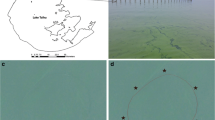Abstract
Among many reports investigating microbial diversity from environmental samples with denaturing gradient gel electrophoresis (DGGE), limited attention has been given to the effects of universal primers and DNA extraction on the outcome of DGGE analysis. In this study, these effects were tested with 16S rRNA gene-based DGGE on a bacterial community from farming water samples. The results indicate that the number of discernable bands in the DGGE fingerprint differed with the primer pairs used; the bands produced by 63f/518r, 341f/926r and 933f/1387r primer pairs were obviously fewer than those by 968f/1401r. Also, we found that each DNA extraction method resulted in different community profiles, reflected by the number and intensity of bands in the DGGE fingerprint. Furthermore, the main bands (theoretically representing dominant bacteria) differed with the extraction methods applied. It is therefore believed that the effects of universal primers and DNA extraction should be given more attention and carefully chosen before performing an investigation into a new environment with DGGE.
Similar content being viewed by others
References
Araya, R., K. Tani, T. Takagi, N. Yamaguchi and M. Nasu, 2003. Bacterial activity and community composition in stream water and biofilm from an urban river determined by fluorescent in situ hybridization and DGGE analysis. FEMS Microbiol. Ecol. 43: 111–119.
Dahllof, I., H. Baillie and S. Kjekkeberg, 2000. rpoB-based microbial community analysis avoids limitations inherent in 16S rRNA gene intraspecies heterogeneity. Appl. Environ. Microbiol. 66: 3376–3380.
Evans, F. F., A. S. Rosado, G. V. Sebastian, R. Casella, P. Machado, C. Holmström, S. Jelleberg, J. D. van Elsas and L. Seldin, 2004. Impact of oil contamination and biostimulation on the diversity of indigenous bacterial communities in soil microcosms. FEMS Microbiol. Ecol. 48: 1–11.
Kalia, A., A. Rattan and P. Chopra, 1999. A method for extraction of high-quality and high-quantity genomic DNA generally applicable to pathogenic bacteria. Anal. Biochem. 275: 1–5.
Li M., J. H. Gong, M. Cottrill, H. Yu, C. Lange, J. Burton and E. Topp, 2003. Evaluation of QIAamp® DNA stool mini kit for ecological studies of gut microbiota. J. Microbiol. Methods 54: 13–20.
Liesack, W., H. Weyland and E. Stackebrandt, 1991. Potential risks of gene amplification by PCR as determined by 16S rDNA analysis of a mixed-culture of strict basophilic bacteria. Microbiol. Ecol. 21: 191–198.
Lipthay, J. R., C. Enzinger, K. Johnsen, J. Aamand and S. J. Sørensen, 2004. Impact of DNA extraction method on bacterial community composition measured by denaturing gradient gel electrophoresis. Soil Biol. Biochem. 36: 1 607–1 614.
Marchesi, J.R., T. Sato, A. J. Weightman, T. A. Martin, J. Fry, S. J. Hiom and W. G Wade, 1998. Design and evaluation of useful bacterium-specific PCR primers that amplify genes coding for bacterial 16S rRNA. Appl. Environ. Microbiol. 64: 795–799.
Martin-Laurent, F., L. Philippot, S. Hallet, R. Chaussed, J. C. Germon and G Soulas, 2001. DNA extraction from soils: old bias from new microbial diversity analysis methods. Appl. Environ. Microbiol. 67: 2 354–2 359.
Massana, R. M. and C. Pedrós-Alió, 2000. Spatial differences in bacterioplankton composition along the Catalan cost (NW Mediterranean) assessed by molecular fingerprinting. FEMS Microbiol. Ecol. 33: 51–59.
More, M. I., J. B. Herrick, M. C. Silva, W. C. Ghiorse and E. L. Madsen, 1994. Quantitative cell lysis of indigenous microorganisms and rapid extraction of microbial DNA from sediment. Appl. Environ. Microbiol. 60: 1 572–1 580.
Mota, F. F., E. A. Gomes, E. Paiva and L. Seldia, 2005. Assessment of the diversity of Paenibaccillus species in environmental samples by a novel rpoB-based PCR-DGGE method. FEMS Microbiol. Ecol. 53: 317–328.
Muyzer, G. and K. Smalla, 1998. Application of denaturing gradient gel electrophoresis (DGGE) in microbial ecology. Anton. Leeuw. Int. J. Gen. Mol. Methods 56: 365–373.
Orisini, M. and V. Romano-Spica, 2001. A microwave-based method for nucleic acid isolation from environmental samples. Lett. Appl. Microbiol. 33: 17–20.
Rombaut, G., G. Suantika, N. Boon, S. Maertens, P. Dhert, E. Top, P. Sorgeloos and W. Verstraete, 2001. Monitoring of the evolving diversity of the microbial community present in rotifer cultures. Aquaculture 198: 237–252.
Stach, E. M. J., S. Bathe, J.P. Clapp and R.G. Burns, 2001. PCR-SSCP comparison of 16S rDNA sequence diversity in soil DNA obtained using different isolation and purification methods. FEMS Microbiol. Ecol. 36: 139–151.
Suzuki, M. T. and S. J. Giovannoni, 1996. Bias caused by template annealing in the amplification of mixtures of 16S rRNA genes by PCR. Appl. Environ. Microbiol. 62: 625–630.
Tacâo, M., A. Moura, A. Alves, I. Henriques, M. J. Saavedra and A. Correia, 2005. Evaluation of 16S rDNA-and gyrB-DGGE for typing members of the genus Aeromonas. FEMS Microbiol. Lett. 246: 11–18.
Trochimchuk, T., J. Fotheringham, E. Topp, H. Schraft and K.T. Leung, 2003. Comparison of DNA extraction and purification methods to detect Escherichia coli O157:H7 in cattle manure. J. Microbiol. Methods 54: 165–175.
von Wintzingerode, F., O. Landt, A. Ehrlich and U. B. GÓbel, 2000. Peptide nucleic acid-mediated PCR clamping as a useful supplement in the determination of microbial diversity. Appl. Environ. Microbiol. 66: 549–557.
Watanabe, K., Y. Kodama and S. Harayama, 2001. Design and evaluation of PCR primers to amplify bacterial 16S ribosomal DNA fragments used for community fingerprinting. J. Microbiol. Methods 44: 253–262.
Author information
Authors and Affiliations
Corresponding author
Additional information
This work was funded by the Special Scientific Foundation of Guangdong Province (No. A305030301) and was partly supported by a grant from KLFEE, Ministry of Agriculture (2003-04).
Rights and permissions
About this article
Cite this article
Luo, P., Hu, C., Zhang, L. et al. Effects of DNA extraction and universal primers on 16S rRNA gene-based DGGE analysis of a bacterial community from fish farming water. Chin. J. Ocean. Limnol. 25, 310–316 (2007). https://doi.org/10.1007/s00343-007-0310-7
Received:
Accepted:
Issue Date:
DOI: https://doi.org/10.1007/s00343-007-0310-7




